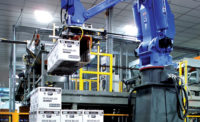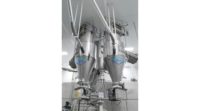
By Dan Malovany
Like a loosely knit family, each of J&J Snack Foods’ 10 bakery production facilities act like adoptive brothers and sisters who are of different ages and who are doing their own things, but are somehow related and come to the better good of the company in the end.
And it’s up to Tom Weber, vice president of operations, and his small corporate staff to help preserve their individual characters while making sure they work together in harmony.
“They, more or less, run independently with oversight from the parent company,” he says. “Instead of a streamlined kind of operation, I would describe ours as an efficient patchwork quilt.”
In some cases, the bakeries may show a bit of age with production on multiple floors like Uptown Bakeries in Bridgeport, N.J., where it supplies fresh croissants, bagels, muffins, donuts, fancies and soft pretzels - both conventionally twisted or in a hearty, Philadelphia-style form - for some 570 Wawa convenience stores, 365 days a year.
On the other hand, its flagship Pennsauken, N.J., plant annually cranks out 500 million filled and conventional soft pretzels in a relatively straight-line production. Likewise, production at its Country Home Bakers operation in Atlanta runs in a straight line as well, but nothing is baked and everything is frozen.
Then, go to the Bellmawr, N.J., operation, which produces raw pretzel dough, baked pretzel sticks, cookie dough, churros, conventional pretzels, funnel cakes and even the new “funnel fries,” which are a sweet alternative to its potato counterpart.
There’s really no rhyme or reason to the plants’ locations. That’s because for nearly four decades as J&J Snack Foods acquired them, the mantra wasn’t location, location, location as it is in the real estate industry.
“It was all about how each business fits into the portfolio at that time,” Weber says. “We really didn’t buy it for where its location was. As a result, they’re scattered all over the place to some extent.”
However, with the exception of shifting some production, there is no intention to fix that.
“Because they work,” adds Bob Radano, senior vice president and COO.
To improve its operations, J&J Snack Foods is constantly looking for ways to enhance product quality or new technology to operate more efficiently.
In Pennsauken on the extruded soft pretzel line that makes pretzels filled with cheese, pizza sauce and other fillings, the company installed a PLC-controlled flexible oven where temperature is highly regulated while providing a maximum in operational efficiency of the delicate products.
“You can change anything on a dime with it,” Weber says. “The older ovens are direct fired, and the only way to control them is to turn on or shut off a burner.”
To improve consistency and food safety, the company is moving away from traditional third-party audits and toward the Global Food Safety Initiative that’s much more comprehensive and is being recommended by many of the world’s largest retail and foodservice chains. Everything from record keeping and lot tracing to good manufacturing practices and Hazardous Analysis Critical Control Points (HACCP) programs already has been completed at two plants and should be rolled out system-wide during the next two years.
“All of our customers want them to be done right now, but the auditing companies don’t have enough auditors,” Weber notes.
Moreover, a new high-volume, hot water sanitizing system has improved sanitation by providing better cleaning of equipment and the building itself at the Pennsauken plant. Additionally, high-intensity fluorescent lights have enhanced sanitation and provide energy savings, as well as a rebate from the state of New Jersey.
For food safety, handheld microbial systems now provide instantaneous results for testing products, equipment and other food contact places. In the past, third-party analysis of swabbing of equipment could take up to a week to complete.
The commodity crisis of last year forced many other food companies to tighten their operations. In response, J&J Snack Foods installed an operating system to seek out ways to eliminate waste, monitor ingredient productivity and improve throughput.
Within the last 12 months, those ingredient and fuel costs have become more reasonable, but the company hasn’t changed its procedures. Rather, it monitors commodities, energy and fuel usage almost daily to add more predictability to its purchasing decisions.
As Radano explains, “We don’t want any more surprises. Rather than save a few bucks here, I’d rather know what I’m going to pay next January instead of getting hit with big increases.”
Additionally, a predictive maintenance program can issue work orders and provide other information to minimize downtime. It does everything from ordering parts and providing vendor verification to monitoring equipment usage and machine history to keep its operations running full throttle, Weber says.
Shipped to Order
On a good day, the 100,000-sq.-ft. Pennsauken facility will crank out 2.1 million soft pretzels, or about 10 trailer loads on a daily basis. That’s about 500 million products annually.
Even that volume, however, is not enough to meet the demand for its signature products. In fact, Weber notes, an additional 10 trailers of various varieties of soft pretzels, frozen novelties, cookies, filled churros and frozen bread must be shipped daily from the company’s other facilities to Pennsauken’s central warehouse where some 200 SKUs [stock-keeping units] are pre-staged one day in advance to streamline shipping. The goal is to provide made-to-order distribution and to get the trailer loads in and out as efficiently as possible.
“We don’t have a whole lot of trucks that have only full pallet loads,” Weber says. “A normal truck for us was 60% to 70% full pallets of various products and the other 30% to 40% were hand-builts that include one case of this product and another case of that product or a partial pallet of one product with a layer of a second product.”
Overall, four silos, ranging from 40,000- to 80,000-lb. capacity feed the seven lines with about 250,000 lb. of flour a day. The conventional soft pretzel lines produce about 100, 5-oz. pretzels a minute, but one line pumps out twice that amount, or about 4,000 lb. an hour. Since it was built in the mid-1990s, that line has been affectionately referred to as the “dream line” because Gerry Shreiber, chairman, president and CEO of the company, wanted to build a line that produced twice the volume of product of the plant’s other lines with half of the number of people.
“All of the engineers said, ‘You’re dreaming,’” Weber says, and the name stuck.
That line, which has its own dedicated flour silo, is integrated with programmable logic controls that monitor everything from mix feeds to temperature in the 88-ft. oven and all safety interlocks.
To meet production demands, a continuous mixer extrudes 15-lb. dough chunks that glide on a conveyor and, with the use of photo-sensitive eyes, feeds the hoppers on eight soft pretzel twisters, each of which are aligned to feed a specific section of the conveyor belt below.
After a brief ambient proof, the soft pretzel pieces receive a caustic bath that gives them their reddish brown texture and seals in moisture before baking for three minutes. The products then flip out of the oven onto a conveyor underneath and travel the length of the oven toward the make up area before dropping to a second cooling conveyor back toward the freezer. That allows the soft pretzels to cool down from 240ºF to 140ºF, which reduces freezing time and saves energy. At any given moment, there are 9,000 pretzels on the spiral freezing conveyors.
Both of the extruded lines make 1-, 3.5- and 6.5-oz. pretzels filled with cheese, jalapeño, pizza and other flavored sauces. The larger sizes are hand tied because of the product’s delicate nature. A bank of six workers can each tie about 20 per minute. Every 20 minutes, quality control personnel pull a piece from the line, weigh it, then scrape out the filling and weigh it a second time and subtract it from the first measurement to make sure the correct amount of filling is being used.
All freezers feed the temperature-controlled packaging room, which relies on everything from automatic scaling and form/fill/sealing of pretzel bites to products that are bulk packed for foodservice while others that need to be hand-packed because of the unusual configuration of the packaging. Overall, 80% of soft pretzels are sold to foodservice customers. However, because of the automation in this plant’s packaging area, the bulk of retail pretzels - or about 40% of the plant’s volume - is packaged for the retail channel.
Just Like Home
Down in Atlanta, the 85,000-sq.-ft. Country Home Bakers’ seven lines produce 75 million lb. of products annually, although the facility has done 131 million lb. in the past and could reach to 150 million lb. if pushed to the limit, says Mike Harvison, vice president and general manager.
A battery of horizontal mixers range from 1,300- to 2,000-lb. capacity. Two lines can make 12,000 lb. of frozen cookie dough an hour. DuringSnack Food & Wholesale Bakery’svisit, the lines were making whole grain cookies for a school lunch program.
The bakery also features a bread line with an eight-pocket divider, two cone rounders and dual sheeter/moulders that were making 150 pieces of Italian bread per minute. The versatile hard roll line is outfitted with a variety of sheeters, rollers, stampers and cutters to produce a variety of products. Next to it, the eight-pocket, high-speed roll operation turns out dinner rolls at rates from 1,040 to 1,440 pieces per minute. In a separate room, a versatile 40-in. wide sheeting line produces cinnamon buns while the biscuit line cranks out 7,000 lb. of products per hour for its Hom/Ade subsidiary and others.
All production runs toward two single and one double spiral blast freezers. One of them is dedicated for cookie production while the other two handle the remainder of products. In a separate packaging room, the bakery uses an automatic palletizer, box erectors, automatic scales and form/fill/seal machines to streamline the back end of the operation. However, it still hand-packs cookie dough.
“We found it would be too complicated to put in automated packaging with 250 SKUs of cookies and so many different box sizes,” Harvison says.
In the R&D lab, products are baked off in rack ovens by the QC staff while Don McComas, a certified master baker, oversees new product development and works directly with national foodservice and in-store bakery accounts to custom-design signature products, many of which are created by him and approved for production in four to six weeks.
“Often, our customers don’t know what they want specifically, but they can tell you what they’re looking for,” he says. “I just go to the bench and start working on a formulization to make sure it’s what they want. Most of the time, we hit it on the head.”
From Fresh to Frozen
SF&WBmagazine also visited two other bakeries. Its Uptown Bakeries is the only plant that produces and distributes fresh product daily. Production ranges from 30,000 muffins to 100,000 bagels daily to 15,000 lb. of extruded pretzels a week. Each day, it makes 25 to 30 different types of products - some of them injected with fruit or cream fillings - and anywhere from 12 to 16 varieties of donuts, thousands of hand-twisted pretzels and even more croissants for breakfast or for making sandwiches at the convenience store level.
Innovation rules at this operation, says Tom Hunter, its vice president and general manager. During the past decade, he estimates that the bakery has developed about 100 new donut varieties. Each year, the operation produces 150 to 200 new products or flanker brands that are used for limited-time only or as a seasonal product.
During the past six years, Hunter adds, Uptown Bakeries has boosted its capacity by 80% to more than 140 million units annually. Most of the products are placed on 1,500 racks for daily delivery. Moreover, the bakery has reduced downtime to less than 2% to help meet its tight delivery schedule, Hunter notes.
“If we miss a window, we miss the sale,” he says.
At the 180,000-sq.-ft. Bellmawr bakery, the building has plenty of room to expand with only 35,000 sq. ft. used for production and 90,000 sq. ft. for warehouse space. The bakery, however, cranks out plenty of unique products such as 50,000 funnel cakes or 65,000 lb. of cookie dough per day.
The facility also has a large maintenance area for rebuilding its mobile soft pretzel, churros and funnel cake display warmers. Last year, the department reconditioned an estimated 10,000 warmers, which are leased or sold to movie theaters, sports arenas, malls and other foodservice establishments.
In the end, these bakeries may operate differently than one another, but as individual threads of the company’s grand design, they fit together in their own unique way.



